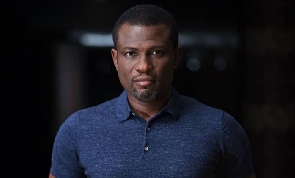Riches laid in foundation during Ghanaian ritual
Maryland, USA -- The African chief swayed in a plywood-lined trench.
Eyes clenched, his head fell back, his gray beard pointed skyward.
His royal entreaty pricked the cool air: "Great Spirit, the Supreme state, we call on you."
At his signal, a palmful of pure Ghanaian gold was reverently laid into a puddle of muddy water and liquor, only to be quickly covered by five inches of gray concrete.
Surrounded by the principals of the Reginald F. Lewis Museum of Maryland African American History and Culture, set to open next year near the Inner Harbor, the chief performed yesterday an ancient ceremony to link the museum's foundation with the spirit of Africa.
"To bring the strength, the wealth, the prosperity to this building," explained the chief, Nana Amanyi I, of the Swedru region of Ghana.
The gold ceremony is performed in the West African nation when a major building is constructed or the foundation of a home is laid, according to Yao Dei, cultural attache to the Ghana Embassy in Washington, D.C. "It gives us strength," Dei said.
Crews broke ground in December for the $33 million, 82,000-square-foot museum. Only Detroit's Charles H. Wright Museum of African American History, which opened six years ago, will house a larger collection of arts from the African Diaspora.
The museum honors Lewis, the late Baltimore-bred financier and philanthropist who shared a list of his charitable priorities shortly before his death in 1993 with his aunt, Beverly A. Cooper.
A key priority was a museum of African-American history, she said.
Cooper tracked down George L. Russell Jr., a former Baltimore City Circuit Court judge who was searching for a way to bring such a museum to his hometown.
It was a somber but elated Russell, who is chief executive officer of the museum, who took part in the ceremony yesterday morning.
"This is a very serious act and a deep and spiritual act," he said, following the chief, who goes by the Western name of Willie B. Lamouse-Smith and works as a professor of African studies at the University of Maryland, Baltimore County, into the trench.
After explaining the significance of the ritual to the museum's board members, Lamouse-Smith emptied about a pint of water from a carved calabash gourd into the trench. "We cleanse ourselves," the chief intoned.
Then he splashed tumblers of aromatic Dutch schnapps -- poured from a square, green bottle -- on the pale, stony mud at the base of the foundation's western corner. A light breeze carried the scent of juniper berries up to the fenced area where a dozen construction workers and museum employees watched.
"Mother Earth, come take the libations. Spirits of great ancestors, we call you!" he said.
The air was mostly silent, save for the rumble of the concrete mixer, readied to cover the treasures at the end of the ceremony.
Russell carried a glass vial filled with 24-carat gold dust to represent spiritual purity. Board member Aris T. Allen cupped a thimble-sized nugget of 23.5-carat gold, symbolizing strength and endurance. Carolyn Fugett, mother of the museum's patron, softly cradled an 18-carat gold chain, its links emblematic of the Ghanaian belief that past, present and future are entwined.
One at a time, they stepped forward to make their offerings. The dust splashed in the surface of the puddle created by the water and liquor. The nugget settled next to the moist spot. The chain, a fashionable necklace, draped across the mud.
Wearing tall, yellow galoshes, construction superintendent Johnnie Lee Martin immediately scooped shovelfuls of the wet concrete around the offering. Then he swiveled the shoot from the orange mixing truck, and a lumpy stream buried the shining metal.
Spontaneous applause and cheers broke out among the small crowd.
Russell, blinking moist eyes, relished the experience of taking part in an ancient African tradition to make way for a new African-American museum.
"It's been 10 years," he said. "Quite a moving thing."
"Mind-boggling," Fugett added quietly. "So spirit-filled. In our family, you have to have a good foundation to succeed."
Yesterday's gold-planting ceremony was shrouded in secrecy. A press release for the event didn't mention the exact date, for security purposes.
Baltimore, is, after all, the city where addicts scavenge copper piping and aluminum fixtures from the walls of abandoned rowhouses to sell to scrap-metal dealers. The thought surfaced soon after the ceremony ended.
"I hope the concrete hardens before it gets into the newspapers," Allen said, laughing nervously. "When it cures and sets up, I'll feel better."
A site foreman predicted the concrete would dry before rush-hour, but Peter Yeboah wasn't worried.
Yeboah, who carried the ornamental gold koduo that held the three gold items before the ceremony, said natives of Ghana believe that thieves of ceremonial gold soon regret the crime.
"If you steal it, you'll die," he said, smiling.
Diaspora News of Friday, 23 May 2003
Source: Baltimore Sun
















